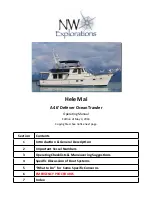
ANGLAIS 01-11-05
Page 25/88
FEELING 39
FEELING – GROUPE ALLIAURA MARINE – BP 231 – 85106 Les Sables d’Olonne Cedex -France
Tel 33 (0)2 51 21 05 38 Fax 33 (0)2 51 96 91 95 – http//:www.alliaura.com
9.1. Launching the boat / settings
NOTE
-
After first launching and tensioning of rigging, check the alignment of the propeller shaft
or the sail-drive flange ring.
-
Ensure that the cooling circuit water intake seacock is open, and that water is coming out
of the engine exhaust.
-
Boats fitted with rotating seal stern gland: bleed the air from the gland after each launch.
On subsequent launches, a brief check of propeller fixing can be made. Incorrect operation of
the folding propeller will lead to vibration
Regularly check the condition of the anodes and ensure that they are suitable for the boat's
environment (fresh water, salt water).
9.2. Exhaust gas emission
DANGER!
Internal combustion engines produce carbon monoxide. Prolonged exposure to exhaust gasses
can have serious consequences, and may even cause death.
Location of technical room beneath cockpit
ANGLAIS 01-11-05
Page 26/88
FEELING 39
FEELING – GROUPE ALLIAURA MARINE – BP 231 – 85106 Les Sables d’Olonne Cedex -France
Tel 33 (0)2 51 21 05 38 Fax 33 (0)2 51 96 91 95 – http//:www.alliaura.com
9.3. Safety
DANGER!
-
In order to avoid all risk of serious injury from the propeller, the engine must not be started
when there are swimmers near the boat.
-
Whenever possible, the engine must be stopped for any engine maintenance or checking
operations. Otherwise, special attention must be paid to moving parts (propeller shafts,
belts, etc.) in order to avoid any risk of injury.
Engine fuel control
Helm position
10. FUEL INSTALLATION
Flexible fuel pipes must be:
- replaced by pipes bearing the same markings
-
replaced in the event of deterioration.
-
fuel tank satisfies EC standards (ISO 10088 standards)
ATTENTION!
-
Depending on the trim and loading of your boat, not all of the nominal fuel capacity may
be usable. Always maintain a 20% reserve for safety.
Never:
- Store flammable materials in unventilated spaces.
- Smoke while filling tanks.
- Obstruct ventilation openings (vents, engine ventilation grilles).
- Modify the installation, unless this is carried out by a technician qualified in this field.














































